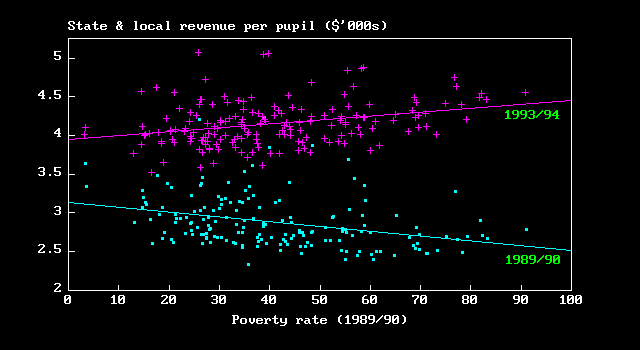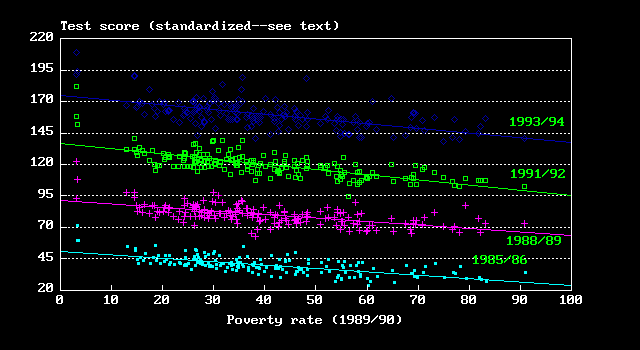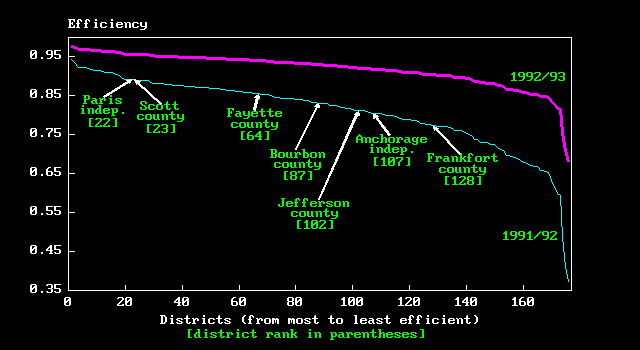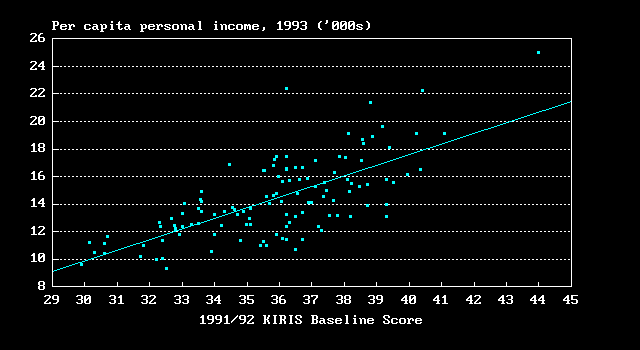
Private and public decision-makers in Kentucky generally agree that increases in educational attainment--referred to by economists as growth in human as opposed to physical and institutional capital--are critical to achieve economic well-being. Furthermore, many observers believe that formal education is becoming more important as the U.S. economy enters the "information age." See, for example, the discussion in S.J. Goetz, "Economic, Industrial Changes Driving Demand for Workforce Training," in Foresight, Kentucky Long Term Policy Research Center (Spring 1995)
Kentucky traditionally has lagged behind other states in educational attainment, but in 1990 the Commonwealth initiated profound and far- reaching systemic reform in K-12 education under the Kentucky Educational Reform Act (KERA). KERA has been described as placing Kentucky "ahead of the pack and likely to remain so" relative to educational reform efforts in other states. Indeed, decision-makers in other states are looking to Kentucky as a leader in educational reform, since no other state has implemented as comprehensive a reform effort as noted by Dr. Rexford Brown of the Education Commission of the States, at a recent Conference on Education in Kentucky: Current Results, Future Visions. [This conference was sponsored by the University of Kentucky/University of Louisville Joint Center for the Study of Educational Policy, Lexington, KY, February 1995 (summarized by Rosetta F. Sandidge)]
Yet, within Kentucky, both the impacts and costs of KERA remain controversial. One controversy is that KERA neglects educational "basics" in its attempt to prepare students for the economy of the future. Another centers on "accountability," and whether or not teachers should or can be held accountable for what students learn. The area of student "assessment" is also highly controversial. Recently, educational experts from outside the state have described the new assessment system (Kentucky Instructional Results Information System) as having serious flaws.
Despite these controversies, it is clear that significant overall advances have been made to date under KERA in increasing resources available for education. The KERA reforms have been implemented across school districts with vastly divergent social, demographic and economic conditions. To illustrate, the share of children qualifying for free or reduced-price school lunch benefits in 1989-90 ranged from over 90 percent in Owsley county to less than four percent in Anchorage, Beechwood and Fort Thomas independent school districts. (Source: Kentucky Department of Education, Profile of Kentucky Schools, Fiscal Year 1989-90, Office of Management Services, Frankfort, Kentucky.)
These district- and county-level economic conditions affect student achievement and the implementation of KERA. If KERA succeeds, local economic conditions may improve in the longer term. However, if students become better-educated under KERA, they may also have greater opportunities to leave the local community for higher-paying jobs elsewhere in Kentucky or other states.
One of the most dramatic effects of KERA has been to eliminate the relationship that historically existed in Kentucky between personal income, poverty rates or property wealth and per pupil revenues available for education. Prior to the reform, districts with a high proportion of students living in poverty (measured by the proportion of the students qualifying for free or reduced-price lunches) received significantly fewer dollars than districts with only a small proportion of impoverished students. Our statistical analysis reveals that prior to KERA in 1989-90, a ten percentage point increase in the poverty rate resulted in a reduction of $62.80 in revenues per pupil.
With the new Support Excellence in Education in Kentucky (SEEK) school funding formula, implemented as part of the KERA reforms, per pupil revenues are now higher in districts that have larger shares of students living in poverty (Figure 1). (With a t-statistic of only 1.52, however, this relationship is not statistically significant at the 10 percent level.)
Per pupil revenues in 1993-94 were greater by $50.50 per pupil for each ten percentage point increase in the 1989-90 poverty rate. This means that students in schools with a high percentage of impoverished students on average receive more dollars per pupil from state and local sources than students in low poverty districts.

Despite the new KERA dollars received from state and local sources, standardized test scores are still lowest in high-poverty districts. Figure 2 depicts scaled school district test scores for four selected years. With the exception of the two KIRIS scores, the different tests are not comparable and we do not necessarily conclude from Figure 2 that scores have improved over time.

Table 1 illustrates how test score averages and standard deviations for the different tests have changed. The coefficient of variation, or c.v., is the ratio of the standard deviation (a measure of variation in test scores across districts) to the mean (the average score for all districts) for each test score. The c.v. has increased over time, suggesting a relatively larger spread (or greater inequality) in results obtained from the various tests. However, whether KERA was the cause of this increase is not clear. If this increased variability is a consequence of KERA, then some schools were able to take advantage of KERA funding to quickly increase test scores, while others were not. In this case, how do these schools differ?
 between 1991-92 and 1993-94. This
increase would reduce the <em>c.v.</em> because the
<em>c.v.</em> is being divided by a larger number (mean).
However, the standard deviation increased by an even larger percentage
(31.6%) so that the net effect was to increase the <em>c.v.</em>
Figure 2 illustrates the greater variation in KIRIS scores in 1993-94
relative to 1991-92. This increased variation is observed for districts at
all poverty levels, and especially at high poverty levels.<p>
Preliminary estimates suggest that increases in math scores in grade
8 between 1991-92 and 1992-93 were significantly greater in districts in
which a high proportion of adults had completed college, and they were
significantly lower in districts with a high proportion of families living
in poverty. This was true after controlling for (1) initial math scores in
1991-92; (2) instructional spending per pupil in 1991-92; (3) growth in
instructional spending per pupil between 1991-92 and 1992-93; (4)
location of the district in urban or rural counties; and (5) whether or not
the district was an independent, rather than a county district.<p>
Math scores increased more in independent districts than in county
school districts, and the difference between the two kinds of districts
was statistically significant. Also, math score increases were smaller in
urban districts than in rural districts. Future research will reveal if these
statistical relationships have persisted in math and other tests administered
since 1992-93.<p>
Economists and educators have advanced a number of explanations
for a negative relationship between poverty and educational achievement:
First, parents in families living in poverty, lacking education themselves,
may be unable to provide help on homework when asked by their
child(ren). Second, students living in poverty have fewer resources at
home (such as desk space in a quiet study environment with good
lighting, an encyclopedia, or a computer) to do homework. Third,
students over the age of 16 may also need to contribute to household
income in poverty-stricken homes. Finally, students living in areas with
high poverty and unemployment rates may see there net returns to
education as low or even <em>negative</em>. As a result, these
students may spend less time and effort on education.<p>
Therefore, an important policy question in the administration of
KERA is, should socioeconomic and demographic conditions in counties
be considered when schools are rewarded or penalized for changes in
achievement scores? Schools in high-poverty districts may find it more
difficult to increase their test scores due to community-level
socioeconomic factors detrimental to learning and beyond the control of school
administrators and teachers. <p>
<h2><em>School Managerial Efficiency</em></h2><p>
School administrators face a number of decisions involving
resource allocation during the school year. These include choosing how
to spend school dollars obtained from local, state and federal sources.
One important decision is how much personnel (principals, teachers,
librarians, guidance counsellors, attendance personnel, bus drivers and
custodians) to employ, given the expected student enrollment. Tax
dollars have many uses besides education spending, and taxpayers expect
school administrators to allocate these dollars wisely.<p>
Research studies directed toward providing guidance to school
administrators and school board members about these decisions do not
always provide the same recommendations. Experts disagree, for
example, on the impact of reducing pupil/teacher ratios on student
achievement. Experts also disagree on the value of additional years of
teaching experience and the value of a graduate degree for classroom
teachers. Yet, Kentucky districts largely base teachers' salaries on these
two factors, rather than more subjective (and possibly costly) measures
of a teacher's ability to teach students. Of course, to the extent that
school districts in Kentucky are successful in increasing student
achievement levels, KERA rewards districts with additional funding, and
some of these funds go into larger salary increases for teachers.<p>
School administrators need to be more than financial managers:
they also must provide educational leadership, and motivation for
teachers and other employees. Different superintendents and their
immediate subordinates bring varying combinations of ability and
experience to their jobs, which will affect school performance. In
addition, superintendents may for various reasons be constrained in the
short run in terms of their ability to respond to KERA's mandates (such
as implementing effective site-based management processes), and factors
such as parent interest and volunteerism may also affect the management
of their schools. Together, this mixture of factors and uncertainty about
how to optimally combine school ) We call the discrepancy between tests scores achieved under ideal
circumstances and those achieved in reality managerial inefficiency.
We rank each Kentucky school district by the difference between the
actual score and the score that should be ideally
attainable, given the dollars available to the district and controlling for
the economic conditions prevailing in the county. The larger the
difference between the actual score and the ideal score in the district, the
more managerially inefficient the district. This measure of inefficiency
results after controlling for factors such as existing pupil-teacher ratios
in each district, teacher salaries, per-pupil spending on administration,
whether the school district is rural or urban and independent or a county
district, the county poverty rate, and the educational attainment of adults
in the community.
We call the discrepancy between tests scores achieved under ideal
circumstances and those achieved in reality managerial inefficiency.
We rank each Kentucky school district by the difference between the
actual score and the score that should be ideally
attainable, given the dollars available to the district and controlling for
the economic conditions prevailing in the county. The larger the
difference between the actual score and the ideal score in the district, the
more managerially inefficient the district. This measure of inefficiency
results after controlling for factors such as existing pupil-teacher ratios
in each district, teacher salaries, per-pupil spending on administration,
whether the school district is rural or urban and independent or a county
district, the county poverty rate, and the educational attainment of adults
in the community.
Results for 176 Kentucky school districts ranked according to this measure in 1991-92 and 1992-93 are presented in Figure 3. The inefficiency measure lies between 0 and 1 (or 0 and 100 percent), with 1 indicating efficiency under ideal (but unrealistic) conditions. The horizontal axis shows the rank of each district sorted from highest to lowest by the inefficiency measure (detailed scores for individual districts by quintile are available from the authors on request). Scores in Paris independent district in 1991-92 were close to efficient--about 15 percent lower than they could be under ideal conditions, while those in Frankfort county were about 23 percent lower. Hence, these two districts were operating at 85 and 77 percent of their maximum possible efficiency, respectively.
This efficiency measure is relative in that it only compares a district relative to others in the same sample. The measure cannot be linked to a absolute, generally valid measure of efficiency. Also, the estimation procedure used to derive the rankings does not allow districts to become more efficient relative to each over time, that is, for one district to "leap-frog" other districts.
Even among districts located in the same county, considerable differences can exist in the ranking. According to Figure 3, districts improved the efficiency with which resources are managed over the two-year period (at least in terms of math scores). Furthermore, our results reveal that the top-spending district (Anchorage independent) was not the most managerially efficient. A district may have a high average student achievement score, and yet be quite inefficient, and vice versa.

In the analysis presented in Figure 3, only grades in one subject and at one grade level were considered. Further, a number of factors (such as whether parents help their children with homework, whether children have appropriate places in the home at which to do their homework, whether parents volunteer in the school, and even how many hours children spend on the school bus) beyond the control of administrators likely affected the efficiency ranking. Despite these caveats, this kind of analysis is useful in identifying school districts with problems. In addition, districts that are comparatively efficient could be studied in greater depth to determine which specific administrative practices and policies make them efficient. This knowledge might be helpful in assisting inefficient districts.
How does education affect local income and income growth over time? While it may be too early to quantify the impacts of KERA on personal income growth in Kentucky, Figure 4 suggests that higher KIRIS baseline scores (in 1991-92) in a county were associated with higher personal income levels in 1993. This is largely a statistical association rather than a cause-and-effect relationship, and caution is warranted, at least in the short-term, in suggesting that KERA will necessarily increase personal income levels.
To construct figure 4, all scores were aggregated from the district to the county level. Research carried out at the level of countries suggests that income growth rates increase as student achievement scores rise (see D.W. Lee and T.H. Lee, "Human Capital and Economic Growth: Test Based on the International Evaluation of Educational Achievement," Economics Letters, 47, 1995:219-225, or S.J. Goetz and D. Hu "Economic Growth and Human Capital Accumulation: Simultaneity and Expanded Convergence Test." Economics Letters, 51, 1996:355-62).

There are three possible explanations for the relationship observed between scores and income in Figure 4. First, higher KIRIS scores are indicative of graduates who are better prepared to enter the workforce and move more rapidly into higher-paying jobs. Second, higher scores in certain subjects, such as mathematics, have been shown in recent research to be associated with higher subsequent earnings. Third, higher scores may help attract industries into a county that require a more highly-educated labor force and that offer relatively higher paying jobs. In addition, of course, factors other than educational achievement also determine income growth in a county.
The relationship depicted in Figure 4 is the kind of long term effect both taxpayers and legislators expect from KERA. Higher personal income levels yield higher tax revenues to the state, perhaps making possible further improvements in Kentucky schools. Previous research has shown that net social benefits to investment in education are positive in the long term. Furthermore, studies have revealed that these net benefits tend to be larger in countries or economies which start from lower educational achievement levels, as in Kentucky.
Although we believe that KERA has the potential to raise personal income in Kentucky counties over time, an important question remains: If KERA succeeds, will better-educated students be more likely to leave impoverished areas, leaving these places in as poor a condition as would have existed without KERA?
Kentuckians generally support the concept and need for educational reform, but controversies persist on specific details. Examples include rewarding schools for higher test scores and restraining revenue growth in high property-wealth districts.
KERA is being implemented across districts with widely diverging socioeconomic characteristics. As a result, it is not surprising that the linkages between KERA reforms, test scores and income gains are not yet as strong as policymakers and the public might expect. Creating a system of common schools that provide equal opportunity for all students as required by the Kentucky constitution is a difficult task even in the most favorable legislative, economic and financial situations.
Still, to the extent that higher incomes are associated with greater educational attainment, and higher educational attainment leads to still higher personal income levels over the long term, the potential benefits of KERA for all Kentuckians are very large. The principal challenge is to break the local cycle whereby low personal income levels lead to low educational achievement, which in turn perpetuates low incomes.